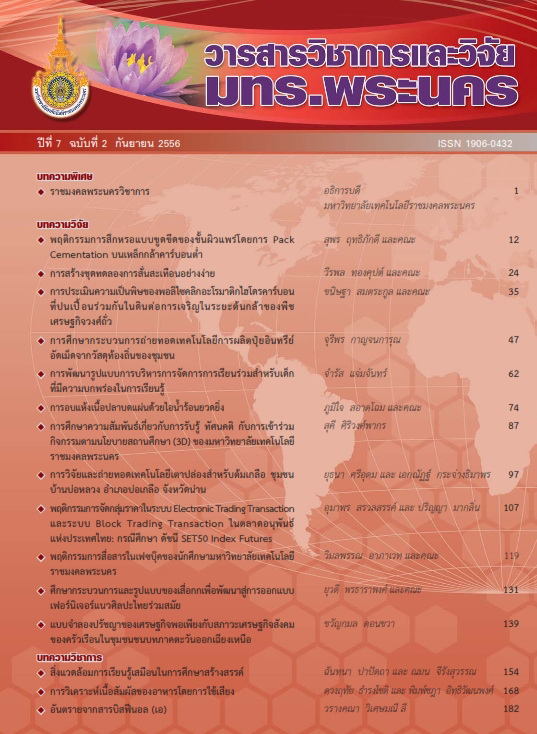การวิจัยและถ่ายทอดเทคโนโลยีเตาปล่องสำหรับต้มเกลือ ชุมชนบ้านบ่อหลวง อำเภอบ่อเกลือ จังหวัดน่าน
Main Article Content
Abstract
บทคัดย่อ
โครงการวิจัยนี้มีวัตถุประสงค์เพื่อทดสอบและเปรียบเทียบประสิทธิภาพเชิงความร้อนของเตาต้มเกลือแบบดั้งเดิมกับเตาปล่องสำหรับต้มเกลือ รวมไปถึงถ่ายทอดเทคโนโลยีเตาปล่องสำหรับต้มเกลือสู่ชุมชน โดยเตาต้มเกลือแบบดั้งเดิมก่อขึ้นรูปด้วยดินเหนียว ส่วนเตาปล่องสำหรับต้มเกลือทำจากอิฐมอญก่อขึ้นรูปและฉาบด้วยซีเมนต์ ตรงกลางบุด้วยฉนวนแกลบดำหนา 3 เซนติเมตร เพื่อลดการสูญเสียความร้อนผ่านผนังเตา โดยเตาทั้ง 2 แบบ สามารถวางกระทะได้ 2 ใบ จากผลการทดสอบประสิทธิภาพเชิงความร้อน พบว่า เตาต้มเกลือแบบดั้งเดิมและเตาปล่องสำหรับต้มเกลือมีประสิทธิภาพเชิงความร้อน 13.1 % และ 16.4 % ตามลำดับ โดยเตาปล่องสำหรับต้มเกลือมีประสิทธิภาพเชิงความร้อนเพิ่มขึ้น 3.3 % ส่งผลให้อัตราการใช้เชื้อเพลิงลดลงเฉลี่ย 12 – 15 กิโลกรัม/วัน จากอัตราการใช้เชื้อเพลิงโดยเฉลี่ย 259 กิโลกรัม/วัน สามารถลดรายจ่ายด้านเชื้อเพลิงเฉลี่ย 14.4 บาท/วัน และมีต้นทุนในการปรับปรุงเตา 1,545 บาท มีระยะเวลาคืนทุน 107 วัน ปัจจุบันมีการปรับปรุงเตาและใช้งานจริง 3 เตา จาก 17 เตา
Abstract
This research aims to test and compare thermal efficiency of salt producing stoves between traditional stove and chimney stove, as well as transfer the technology to community. The traditional stove was constructed from clay while the chimney stove was formed by two layers of bricks coating with cement and then filled with carbonized rice husk ash in the 3cm-space between the layers, in order to reduce heat loss. Both types of stoves could accommodate 2 pans. Results showed that the traditional and chimney stoves had thermal efficiencies of 13.1% and 16.4%, respectively. Thermal efficiency of the chimney stove increased by 3.3% and led to reduction of average firewood consumption rate by 12–15Kg/day from the average consumption of 259Kg/day. As a result, the chimney stove could reduce costs of firewood by 14.4 baht/day. The chimney stove had production costs of 1,545 baht/unit and ROI period of 107 days. At present, 3 of 17 traditional stoves were improved into chimney stove.


